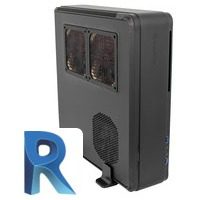Table of Contents
Introduction
Here at Puget Systems, specifically in the Labs department, most of the content that we write falls into one of two categories: either long, fairly in-depth articles looking at the performance of various PC components in a given application or recommended system pages, with multiple configuration options aimed at different budgets and lots of supporting data drawn from the aforementioned articles. For some readers, all of that is information overload, though, and they just want a quick question answered: what is the best computer for my needs? We’re going to try answering that question more directly in a new series of short articles, like this one.
Today we are looking at Autodesk Revit, a BIM application widely used by architects, engineers, and other construction professionals. Revit uses the CPU for most of the behind-the-scenes calculations, whether related to modeling or rendering, while the video card is important for visualizing models and ensuring smooth display when rotating, zooming, or doing walkthroughs.
Because of the variance in CPU usage depending on workload, this article will start with a general-usage Revit configuration but then split up and offer separate recommendations for the best modeling and rendering workstations.
Screenshot of Revit
Good PC Configuration for Revit
We'll start off with a good, solid workstation design for Revit – without too high of a price tag. This application performs best with a CPU that has a high clock speed, with little regard to core count, which means that Intel's latest Core 10th Generation processors do very well here. The Core i7 10700K is a solid choice, and pairing it with 32GB of memory will meet Autodesk's highest recommendation for this program. Likewise, a Quadro RTX 4000 is fast enough to handle most Revit projects – while sticking with NVIDIA's professional-grade video card family. A fast 1TB SSD will ensure that the system is responsive and offers a solid amount of storage space.
| CPU | Intel Core i7 10700K 8-core |
| Video Cards | NVIDIA Quadro RTX 4000 8GB |
| RAM | 32GB DDR4 |
| Drives | 1TB NVMe SSD |
Configure System With These Specs
Best PC Configuration for Design in Revit
Stepping up from there, and focusing on the modeling and design side of things, we can move up to the Intel Core i9 10900K with slightly higher clock speed and a couple of additional cores. Doubling the RAM to 64GB will ensure that even larger projects can be edited without running out of memory, and stepping up to the RTX 6000 video card will cover the graphics side of things in the same way. That video card will also be better equipped to run high-resolution VR headsets, for those wanting to get a feel for what being inside a building will be like before groundbreaking even begins. Additional SSD capacity never hurts, and to protect and investment like this increasing the parts warranty length is a good idea.
| CPU | Intel Core i9 10900K 10-core |
| Video Cards | NVIDIA Quadro RTX 6000 24GB |
| RAM | 64GB DDR4 |
| Drives | 500GB & 1TB NVMe SSDs |
Configure System With These Specs
Best PC Configuration for Rendering in Revit
Unlike general design and real-time visualization, if you are rendering in Revit then having more CPU cores is extremely helpful. Because of that, we recommend switching over to AMD's Threadripper line for folks who want the best CPU-based rendering performance. The top-end of that processor line is the 3990X with a staggering 64 cores, and alongside that, we can max-out the RAM and go with the same Quadro RTX 6000 video card as in the best design configuration above. Rendering will output high-resolution images, or sequences of images if rendering an animation, so increasing the drive capacity further will ensure there is plenty of room.
| CPU | AMD Threadripper 3990X 64-core |
| Video Cards | NVIDIA Quadro RTX 6000 24GB |
| RAM | 256GB DDR4 |
| Drives | 1TB & 2TB NVMe SSDs |
Configure System With These Specs
Please note that this last system is optimized for Revit's built-in rendering capabilities. If you use a plug-in like V-Ray Next or OctaneRender, then please refer to our recommended systems for those applications. Also, with any of these designs, feel free to adjust the specifications to match your exact needs. Individual requirements for things like drive capacity can vary greatly between users.
Additional Resources
If you want to know more about workstation performance, we have published several articles over the years looking at how various CPUs and video cards compare in a wide range of professional programs. And if you aren’t sure what you need, or if your workflow includes multiple applications, please feel free to call or email our consultants to get a more personalized configuration.
Puget Systems offers a range of powerful and reliable systems that are tailor-made for your unique workflow.

